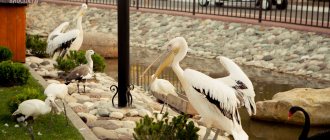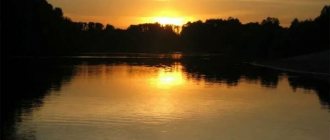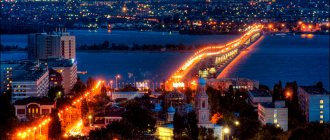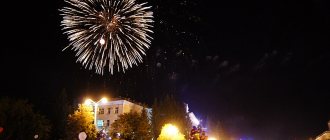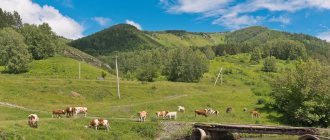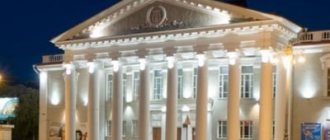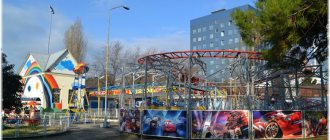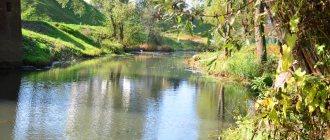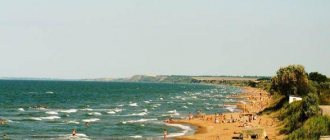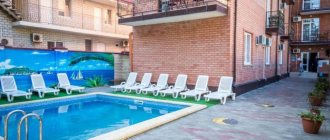Unlike many other Russian border areas, the Kurgan region has adopted little from its southern neighbor Kazakhstan. In terms of culture and leisure, the region looks like a typical representative of the central part of the country. The attractions here are mostly natural, like Lake Bear or the Kurgan Nature Reserve, or religious: the Resurrection Cemetery Church, Borovsky Monastery and others.
There are many museums, theaters and other places of education in the region. There are also truly unique objects, for example, a forest in the form of the inscription “Lenin is 100 years old,” clearly readable from a bird’s eye view. The locals also do not forget about their history, having organized the Tsarevo Settlement Park to preserve the features of the old cities.
The most interesting and beautiful places in the Kurgan region
What to see and where to go? List of the best tourism and active recreation facilities!
Dalmatovsky Assumption Monastery
It was first mentioned in chronicles in 1644. Founded by the Monk Dalmat on the left bank of the Iset. It developed rapidly, was repaired three times after fires, and had its own seminary. After the revolution, the buildings were given over to a museum, and then to a hospital and a factory. In the early 90s, the monastery was returned to its original status. Although it is operational, most of the buildings are in poor condition.
Bear Lake
Located in the Petukhovsky district. Area – more than 6.1 thousand hectares. The maximum depth is approximately 1.2 m. It has no drainage, the water has high salinity, which is why there are no fish or algae. In summer it warms up to approximately +20 °C. 6 islands conditionally divide the lake into Big and Small. A resort has been built on the northern shore, where mud is used to treat a number of diseases.
Kurgansky reserve
Formed in 1985 and has a biological profile. It is located in the Central region and covers an area of more than 31 thousand hectares. The main goals are related to the restoration of animal and bird populations. Particularly protected: muskrat, firebuck, white-headed duck, lesser white-fronted goose, etc. Since the reserve includes settlements and state farms, land development in some areas is permissible and is carried out.
Spaso-Preobrazhensky Cathedral in Shadrinsk
The first stone building of the city. It was erected at the end of the 18th century, the bell tower appeared in the 20s of the 19th century. The main architectural style is one of the subtypes of Baroque with influences from other directions. The streets around the cathedral are named after its altars. The iconostasis is distinguished by its splendor of carvings and rich painting. Until the 70s, the external appearance of the temple changed several times, the original outlines were lost.
Forest “Lenin 100 years old”
The inscription made from living trees was created in 1970, the year the revolutionary’s anniversary was celebrated. It can be found between settlements named Labor and Knowledge. The height is 80 m, the length of the object is 600 m. 40 thousand seedlings were used to create it. The inscription can only be read from above; from the ground it looks like an ordinary forest. The project began to be widely discussed only in the 2000s, although it was not a secret before.
- 30 main attractions of the Bryansk region
Shadrinsky Drama Theater
One of the oldest in the region. Founded in 1896 on the basis of a fair where artists gathered, and a temperance society that organized all kinds of clubs and events. The current building was built in 1910 and can accommodate almost 450 spectators at a time. The theater has a studio where new actors are recruited every year. She stages independent performances that are not part of the regular repertoire.
Resurrection Cemetery Church
Built in the second half of the 19th century in Shadrinsk. This name was obtained due to its location in an old cemetery. The architectural style is Byzantine; a three-tier bell tower was erected nearby. Until 1991, only this religious site remained open. The main value is the Tikhvin Icon of the Mother of God. It was preserved during troubled periods; since the mid-40s, the shrine has not left the church.
Kurgan Aviation Museum
It has been operating since 1985 at the local airport, the only one of its kind in Siberia and the Urals. The exhibition includes 15 aircraft displayed in the surrounding area. The remaining exhibits (uniforms, photos, instruments, etc.) are distributed by period and tell both the history of aviation in general and highlight local features. In 2003, the museum became a branch of the local history department.
Kurgan Regional Museum of Local Lore
Opened in 1951 and originally occupied a church building. In 1991 he moved to the House of Political Education. The museum also includes a planetarium, which reopened in 2011. The exhibition is divided into periods and subtopics and covers different areas. “Zyryanov Readings” are held, environmental programs have been developed, and the lecture hall is used for all sorts of thematic events.
Alexander Nevsky Cathedral
Founded in 1896 in Kurgan. In the period after the revolution, the building changed its purpose several times: a museum, a gym, classrooms, a warehouse, etc. It was returned to believers during Perestroika, and has been a cathedral since 1993. A little later, a new iconostasis was installed, repeating the style of the iconostasis of the Archangel Cathedral of the Moscow Kremlin. The main shrine is the ark with the relics of St. Alexander Nevsky.
Chimeevsky Monastery
Formed in 2002 on the basis of a long-existing parish. Religious objects in Chimeevo were predominantly wooden and periodically burned down or fell into disrepair. Therefore, the update occurred quite often. In addition to the temple, the men's monastery also includes outbuildings. There are few monks here. They protect valuable icons, including ancient ones, and painted iconostasis.
Chimeevsky holy spring
Located near the village of the same name. The spring comes out of the ground, a fence has been built around it, a flooring has been laid and a convenient staircase for descending has been laid. Water is considered medicinal, which has not only a religious, but also a scientific explanation. It contains a lot of silver, so water can have a beneficial effect for a number of diseases. Entrance to the territory is free; many people collect water for future use.
Borovsky Monastery
It was founded in 1992, and in 2000 there was a formal change in status and renaming to the Monastery of the Praise of the Blessed Virgin Mary. The monastery includes: the main temple, a two-tier bell tower, a baptismal temple, a house church, etc. The nuns run an extensive household plot, look after horses, and work in an icon painting workshop. There is a hotel for pilgrims.
Vvedensky Monastery
It has existed in different forms since 1742 in Verkhnyaya Techa. Rebuilding and transformation are associated with many factors, including a large fire that destroyed the monastery almost to the ground. After a long break, the monastery opened in 1995. St. Nicholas Church and other buildings were partially restored, among other things, the frescoes were washed and the iconostasis was restored.
- 25 main attractions of Pereslavl-Zalessky
Lake Gorkoye
It is located near the village of Zverinogolovskoye. It is shaped like a horseshoe, the beach is sandy and wide. The average depth is about 4 meters. Mineral springs were found in the northern part. Mud is considered medicinal and should be applied for only 10 minutes. The bottom is muddy, there is a strip of mud near the shore, in order to get to clean water you need to overcome it. There are several sanatoriums and resorts nearby.
Savin Sanctuary
It is located in the Belozersky district in the floodplain of the river on a hill. It is called the “Ural Stonehenge”. This ancient solar observatory dates back to the 3rd millennium BC. Archaeologists found here two circles with a diameter of up to 16 m. Squares were inscribed in them and special recesses were dug. Sacrifices were dedicated to the sun. Until recently, locals did not come here, fearing evil spirits.
House-Museum of the Decembrists in Kurgan
Founded in 1975 in the building where the Decembrist Naryshkin lived with his relatives for several years. The interiors of that time have been recreated, largely thanks to letters from the owner of the house. The excursion tells about the Decembrist movement and the fate of its participants. On the basis of the museum there is an archaeological club, intellectual games and literary quizzes are held.
House-Museum of V. K. Kuchelbecker
Opened in 2005 in Kurgan in the house where the poet and social activist lived for a year with his family. The house has been restored both inside and out to match the mid-18th century. The exhibition is dedicated not only to Kuchelbecker, but also to his loved ones. The museum's collection consists of personal belongings, letters, early publications and household items of the time. There is a lecture hall where literary evenings are regularly held.
Kurgan Regional Philharmonic
Formed in 1943. The only institution of this type in the region. He is engaged in both concert and educational activities. The first building was a women's gymnasium, later rebuilt into a store; the current one was built in 1984 specifically for the Philharmonic. A special festival named after Shostakovich is held on a regular basis (every two years). A recording studio was opened in 2011.
Regional cultural and exhibition center
Created in Kurgan in 1993 with the aim of promoting the creativity of local artists. The current building has been occupied since 2002. Exhibitions are updated every month. Some of them travel to neighboring cities. Although the focus is on local artists, sculptors and writers, the center also welcomes guests from other regions. The number of halls allows us to do this without harming our own projects.
Kurgan Drama Theater
Founded on the basis of the Shadrinsky Theater in 1943. Initially, he was given the premises of the gymnasium. Ten years later, the troupe moved to a new building, where it is still located. Guest actors from the capital appear from time to time in local performances. The theater participates in Russian and international festivals, and also hosts groups from other cities on its stage.
Park "Tsarevo Settlement"
In the past, this was the name of the city of Kurgan, where the park is located. Based on available historical materials, the authors of the project recreated a wooden fortress in 2013 - the first structure that appeared in these lands in the 17th century. In addition, there is a concert venue, themed entertainment, an excursion into the past, a pottery workshop, colorful photo sessions, etc. There are souvenir shops.
House of engineer F. F. Ostapets
The building is located in Kurgan and stands out from the usual architecture of the city. This wooden castle has narrow carved windows and a figured roof. The building was built at the beginning of the 20th century by order of engineer Ostapets. Probably, the house is a symbiosis of styles and recommendations coming from different fashion trends of that time. Often changed owners and purpose. Nowadays a municipal office is located here.
- Where you can go in Samara and what to see - photos and descriptions of attractions and interesting places
Erokhinskie “kneaves”
Located in the Yurgamysh region. Mud wells are crusty and look like soured dough, hence the name. If you pierce them, dirt of different shades will appear on the surface. You can fall completely into some holes. “Quacks” move around the territory: they dry out in one place, and form in another. The dirt has virtually no odor; the study of the phenomenon continues.
Prosvetsky Arboretum
Created in 1894 as a nursery at the Forestry School. Both plants from the region and samples brought from other parts of the country were planted. About 200 plant species grow on the territory. The main attraction is the pine tree, which is more than 200 years old. Declared a regional natural monument. The Kurgan Regional Arboretum was established nearby in 2010.
| No. | Address of the object | Description of the object | |
| 1 | Dalmatovo Holy Dormition Monastery | Kurgan region, Dalmatovoul. Sovetskaya, 194. | The ensemble of the Dalmatovsky Monastery and the buildings included in it - the Assumption Cathedral, the Church of All Who Sorrow Joy, fortress walls, monastery cells - are objects of cultural heritage of the Russian Federation of federal significance. Founded in 1644 by the icon Dalmat. |
| 2 | Holy Kazan Chimeevsky Monastery | Kurgan region, Belozersky district, village. Chimeevo | Chimeevo is one of the main spiritual centers of the Urals and Trans-Urals with the Miraculous Icon; pilgrims come here from all over our country. In the monastery there is a particle of the life-giving Cross of the Lord, the revealed Miracle-Working Kazan-Chimeevsky image of the Mother of God, as well as a Holy spring with fonts. |
| 3 | Transfiguration Cathedral | Kurgan region, Shadrinsk, st. st. Pionerskaya, 4 | The Transfiguration Cathedral is the first stone building in the city of Shadrinsk. The cathedral was founded in 1771 with the blessing of Bishop Varlaam of Tobolsk. The cathedral, a masterpiece of “Siberian baroque” with a characteristic flaming silhouette of the 18th century, is an object of cultural heritage of the Russian Federation. |
| 4 | Scientific named after Academician G.A. Ilizarov | Kurgan, st. Maria Ulyanova, 6 | The most advanced orthopedic center in the country, where methods for treating many bone defects were used for the first time in the world. It operates a museum of traumatology and orthopedics - the only one in Russia. In the halls of the museum, the method of transosseous osteosynthesis in action is demonstrated using touch screens, “a walk through the human body is carried out.” |
| 5 | Prosvetsky Arboretum "Forest Museum" | Kurgan region, Ketovsky district, Stary Prosvet village | Prosvetsky Arboretum is a natural monument of regional significance. A unique collection of more than 50 tree and shrub and 124 herbaceous plant species grows here. Also of interest is the nearby Forest Museum. |
| 6 | Ecological trail | Kurgan region, Belozersky district, Borovoe village | The eco-trail is located in the eastern part of the Belozersky district of the Kurgan region, on the territory of a specially protected natural area of regional significance - the Belozersky State Natural Zoological Reserve. The trail includes 26 demonstration objects; there are feeding tables for upland game, salt licks for wild ungulates, salt licks for hares, sheds for storing food and much more. |
| 7 | Bear Lake | Kurgan region, Petukhovsky district, Kurort village | Salt Lake Medvezhye - wide beaches covered with snow-white salt, black estuaries and channels with red banks in the thickets of saltwort, high islands with majestic pines and linden trees make this place unique, the most interesting and unusual for the Trans-Urals. |
| 8 | Borovskaya Convent of Praise of the Mother of God | Kurgan region, Kataysky district, village. Borovskoe | “Trans-Ural Kizhi” is the name given to the Trinity Church-chapel in the Borovsky Convent of Praise of the Blessed Virgin Mary in the Kataysky district. The chapel is located in the very center of the Mother of God Garden, the name given to the garden where flowers and rare species of trees are fragrant - blue spruces, cedars, larches, brought from different parts of the Urals. The chapel was built in the Old Russian style - its seven domes are covered with ploughshares, which is why they resemble the famous temple in Kizhi. |
| 9 | Holy Vvedensky Convent | Kurgan region, Kataysky district, village. Upper Techa. | The building of the main monastery church in honor of St. Nicholas the Wonderworker. The iconostasis is four-tiered, covered with aluminum, the carvings and columns are gilded, in the lower two tiers there are icons of ancient painting, and in the upper two - the latest. A wooden cell building was built. There is a house church in honor of St. Seraphim of Sarov, a bishop's house, a house of the monastery's confessor, and a hotel for pilgrims. |
| 10 | Kurtamysh Local Lore Museum named after. N.D. Tomina | Kurgan region, Kurtamysh, lane. Nizhny, 5 | The museum is located in a merchant mansion that belonged to the brothers Nikolai and Stepan Shakhrin. The house was built in 1914 and features original architecture, with an enclosed courtyard and outbuildings. The museum's exhibition invites a contemporary to plunge into the forgotten world of old Kurtamysh. |
| 11 | Lake Gorkoye-Zverinogolovskoye | Kurgan region, Zverinogolovsky district, Iskra village | Lake Gorky has a horseshoe shape and, by its origin, is a fragment of an ancient riverbed. The lake water is sodium bicarbonate-chloride with high alkalinity. Therapeutic mud of the lake. Gorkoe – Zverinogolovskoe are indicated for external use in the treatment of various diseases. |
| 12 | Lake Gorkoye-Uzkovo | Kurgan region, Kurtamysh district, west of the village of Uzkovo | It has been a natural monument of regional significance since 1984. It is located in a small hollow, surrounded on all sides by forest. Almost the entire bottom area is covered with highly alkaline good silt mud. The mud of the lake is distinguished by the complete absence of gypsum crystals, a delicate clayey and unique microbial composition, which determines the presence of sulfur compounds in the mud, and an abundance of antibiotic products and biostimulants. |
| 13 | Lake Gorkoye-Victoria | Kurgan region, Shchuchansky district, p. Resort | The shallow lake is very famous due to the balneological properties of silt mud and brine. The purest salt water and birch groves surrounding Gorky Lake attract thousands of vacationers. It reaches a depth of only 2-3 m. Bottom sediments are represented by mineral mud and mineral waters that have medicinal properties. The water is alkaline, with high mineralization. |
| 14 | Museum "Russian Izba" | Kurgan region, Kargapol district, village. Tagilskoe | The museum welcomes guests in a hut with a hundred-year history. The hut boasts a Russian atmosphere; here guests are treated to original Russian dishes and drinks from a Russian oven, they tell and show how people lived in the past. |
| 15 | Alakul burial ground | Kurgan region, Shchuchansky district, village. Pivkino | The eponymous monument dates back to the 17th-14th centuries BC (Bronze Age). |
| 16 | "Trans-Ural Stonehenge" | Kurgan region, Belozersky district, municipal village. Zyuzino and s. Buzan | Archaeological monument-observatory of the sanctuary of the Chalcolithic-Copper-Stone Age of the 3rd millennium BC. Savin-1. |
| 17 | Landscape park | Kurgan region, Kargapol district, r.p. Kargapolye, st. M. Gorky | The most important feature of this attraction is that the Kargapol district is the only one in the region that has a landscape park. |
| 18 | Forest “Lenin 100 years old” | Kurgan region, Zverinogolovsky district, 1.5 km from the village. Zverinogolovskogo towards the village of Trud and Znanie | One of the most original attractions of the Kurgan region is a forest planted in the form of a huge inscription “Lenin is 100 years old.” This inscription can be seen even from space. The living inscription was created in 1970 (according to other sources - in 1967) for the 100th anniversary of the birth of the revolutionary and creator of the Soviet state V.I. Lenin. The inscription took 40 thousand pine trees. The length of the inscription is 600 meters, the size of each letter in height is 80 meters. |
| 19 | Theater "Gulliver" | Kurgan, Sovetskaya st. 104 | One of the oldest puppet theaters in Russia is located in a historical building of the early 20th century, built by the parents of the famous Russian poet S.A. Vasilyeva. |
| 20 | Museum named after K.D. Nosilova | Kurgan region, Shadrinsky district, village. Pogorelka, st. Isetskaya, 17. | The museum is located on the territory of the Nakhodka dacha, where Konstantin Dmitrievich, a great traveler, famous writer and scientist, journalist, geographer, meteorologist, ethnographer and hunting enthusiast, as well as a northern explorer, lived for 23 years, there is also an alley of old-growth trees, a monument memorial, chapel in the shape of a cross named after. St. George the Victorious, a stele to the Traveler was installed, a model of the yacht Yalmal was installed. |
| 21 | House-Museum of T.S. Maltseva | Kurgan region, Shadrinsky district, village. Maltsevo, st. Shkolnaya, 51 | In the House-Museum of T.S. Maltsev, the office and library of the author of the innovative system of dumpless farming, Hero of Socialist Labor, were recreated in their original form. The exhibition is dedicated to the scientific activities of the collective farm scientist Terenty Semenovich Maltsev. |
12/19/2016 13:405233Dalmatovsky Assumption Monastery.
Photo from the series “Collection of Landmarks of the Russian Empire by S. M. Prokudin-Gorsky”, 1912Commons.wikimedia.org In December, the Center for Information Communications “Rating” published the results of a study on the tourist attractiveness of the country’s regions, their tourism potential and popularity among domestic and foreign tourists.
In this rating, the Kurgan region took 74th place out of 85. At the same time, next to the Trans-Ural region are the Republics of Khakassia, Chechen, Tyva, Mordovia and the regions of Penza and Oryol. The first places in the ranking went to Moscow and St. Petersburg, and the last place went to the Chukotka Autonomous Okrug.
What sights are the Trans-Urals famous for - in the material "AiF-Kurgan".
Bear Lake
In the Kurgan region, not far from Petukhovo, there is Lake Medvezhye, unique for this area. It is also called “local Israel”, because. The chemical composition of the lake's water and mud is similar to the Dead Sea. There are no fish or algae in it and it’s all because of the salt. In summer, Artemia crustaceans breed in large numbers in the lake, giving the lake a peculiar brown color and secreting enzymes that have a calming effect.
The lake itself is large, drainless, fed by meltwater. But the average depth is 50–70 cm, and the maximum is 120 cm. In winter, the lake practically does not freeze.
Article on the topicBetween Europe and Asia. Places in the Southern Urals that you need to show your friends
The most beautiful rivers and lakes of the Kurgan region
The territory of the small Kurgan region contains about 3,000 lakes and several large rivers.
Tobol River
- Coordinates: 55.542218, 65.490077.
The magnificent, full-flowing Tobol River flows through the entire territory of the region - an invaluable gift of nature, which played a huge role in the formation of Kurgan cities and villages.
The river originates in the Orenburg region, crosses the Kostanay region of Kazakhstan, pierces the Kurgan region from southwest to northeast and goes to the Tyumen region, where it flows into the Irtysh.
There are dozens of settlements on the banks of the Tobol, including Kurgan itself. The river is rich in fish, it contains crucian carp, roach, ruffe, carp, perch, pike perch, pike and other species.
Lake Gorkoye-Polovinnoye
- Coordinates: 54.716749, 66.184320.
Bitter-salty lake in the Polovinsky district. The lake received its interesting name for the bitter taste of the water, saturated with minerals.
Centuries ago, a pine forest rustled in its place, but over the years the soil under the trunks collapsed and the trees collapsed into the resulting hole. Springs gushed at the bottom, the depression filled with water, and the pine trees rotted and turned into healing mud. Every half century the lake changes shape and size, sometimes expanding, sometimes narrowing.
In 1985, the reservoir was given the status of a hydrological natural monument. Gorkoye, together with the surrounding forests and steppes, is part of the Zeleny Borok natural monument.
Lake Zverinogolovskoe
- Coordinates: 54.415071, 64.561610.
In addition to the Polovinsky reservoir, in the Kurgan region there are a dozen more lakes with the same name. To distinguish them, the name of the nearest settlement or the entire region is added to the name of the lake.
Thus, the Zverinogolovsky district has its own Gorky Lake. A reservoir resembling a huge horseshoe lies in the vicinity of the village of Iskra. Water with high alkalinity and mud help in the treatment of many diseases, including chronic ones.
Lake Gorkoye-Victoria
- Coordinates: 55.123533, 62.544528.
The drainless lake in the Shchuchansky district is considered the second most popular and important resort reservoir in the region. On its shores in the village of Ozero Resort there is the oldest balneological health resort in the region, founded in 1910.
Currently it is a children's psychoneurological sanatorium. In Gorky there is a thick layer of sulfide silt mud, which, together with water, is used in the treatment and rehabilitation of sick children.
The lake is home to plants typical of salt water bodies and a rare species listed in the Red Book - the sea hornet. The banks are overgrown with reeds and birches. Nearby there is another lake, Gorkoye, with which Gorkoye-Victoria is often confused.
Lake Shamel
- Coordinates: 54.860331, 62.483442.
Safakulevsky district also boasts the presence of a valuable bitter-salty lake. The endorheic reservoir near the village of Martynovka is known by two names – Shamelya and Sulfatnoe.
Rich deposits of healing mud were found in the lake. Due to the high salt content in the water, the lake does not freeze even in the most severe frosts. The reservoir contains only Artemia crustaceans, which the famous traveler Peter Pallas called “scarlet water worms.” There are no sanatoriums or recreation centers on the banks of Shamel, but it is popular among vacationers.
It is important to remember: in case of some diseases, swimming in salt water is dangerous to health, but even in the absence of contraindications, you cannot stay in the lake without breaks for more than 20 minutes.
Dalmatovsky Assumption Monastery
If you want to plunge into history, then welcome to the Dalmatovsky Assumption Monastery. It is located in the city of Dalmatovo on the left bank of the Iset. The ensemble of the monastery and the buildings included in it - the Assumption Cathedral, the Church of the "Joy of All Who Sorrow", fortress walls, monastery cells - are objects of cultural heritage of the Russian Federation of federal significance.
The monastery was founded in 1644 by the monk Dalmat, in the world - Dmitry Ivanovich Mokrinsky. He settled in a cave on the high bank of the Iset River at the confluence of the river. Techa, called the White Settlement. Soon devotees flocked to him. This was the first Russian settlement in the Iset valley. With the blessing of Tobolsk Archbishop Gerasim (Kremlev), a chapel, cells, and a palisade were built. Soon all the buildings were destroyed by fire. Only the icon of the Dormition of the Most Holy One remained unharmed. The Mother of God, which Dalmat brought in 1644 to White Gorodishche. This image became the main shrine of the monastery. New construction began, but the buildings of the monastery were destroyed more than once by fires.
Bastion of the Dalmatovo Monastery. Photo: Commons.wikimedia.org/ photo by Marina Mitrokhina
Today, the surviving complex of buildings was formed mainly in the 1707–1760s. The Dalmatovsky Monastery was the first stone monastery to be built in the Urals and Siberia and the largest stone ensemble after the Tobolsk Kremlin.
There is a museum at the monastery that houses exhibits from the pre-revolutionary period, household and personal items of that era.
Article on the topicFrom the earth to the cross. Guide to the most interesting temples in the region
Holy Kazan Chimeevsky Monastery
The Holy Kazan Chimeevsky Monastery was founded on July 17, 2002. At the meeting of the Holy Synod of the Russian Orthodox Church that took place that day, it was decided to satisfy the request of Bishop of Kurgan and Shadrinsk Mikhail (Raskovalov) to transform the Kazan parish of the village of Chimeevo.
The village of Chimeevo is located in the Belozersky district of the Kurgan region, 90 kilometers north of Kurgan. The village was first mentioned in sources in 1681. A convict named Chimeev settled on the river bank. Soon other people began to join him and over time a settlement was formed, to which the authorities assigned the status of a settlement.
According to legend, a large icon of the Most Holy Theotokos and the Infant Christ sailed to the village along the river. The children saw her. The icon stopped in front of the guys. The children called the adults and the icon was taken out of the river and transferred to the temple in honor of Constantine and Helena. After this, the first breakdowns began to appear in the church.
Another miracle is associated with the appearance of the icon of the Most Holy Theotokos. The village had problems with water, and then a spring appeared. Local residents noticed that water helps against various diseases.
Holy spring of the Holy Kazan Chimeevsky Monastery of the Kurgan and Belozersk diocese. Photo: Commons.wikimedia.org/ photo by Olga Slotvinskaya
Soon there was a fire in the church, but the Icon of the Most Holy Theotokos survived. A new church was built in 1774; almost 100 years later, in 1890, residents erected a new wooden church. This time it was consecrated in honor of the appearance of the Kazan Icon of the Mother of God. This temple, despite its wooden construction and difficult fate, has survived to this day. Currently, the monastery continues to operate. In the temples of the monastery, services are performed every day.
Mammals
The region is home to 69 species of mammals from 6 orders and 17 families, of which 29 species from the order Rodents, 15 species from the order Carnivores, 11 species from the order Insectivores, 9 species from the order Chiroptera, 3 species from the order Artiodactyls and 2 species from the order Lagomorphs.
The lynx lives sedentary in dense dark coniferous forests, but sometimes enters the forest-steppe.
Squad: Carnivores
Brown bear
(lat. Ursus arctos) is a mammal of the Bear genus, Bear family. Rare, only isolated visits to the north of the region in the Shatrovsky district have been recorded. It is found in dense forests with windbreaks, dense undergrowth and tall grass. Photos
Wolverine
(lat. Gulo gulo) is a species of mammal from the genus Wolverine, a strong and ferocious predator. Rare, found in the north of the region in the Shatrovsky State Zoological Reserve in cluttered dark coniferous and mixed forests. Photos
Wolf
(lat. Canis lupus) is a predatory mammal of the Canidae family. It lives in a wide variety of landscapes, preferring open ones and, if possible, avoiding continuous forest areas. The number of wolves in the region is about 50 individuals. Photos
Lynx
(lat. Lynx lynx) is a predatory mammal of the Feline family. Prefers large forested areas, dense deciduous forests with dense undergrowth, providing plenty of shelter. The number of lynx in the region is about 40 individuals. Photos
Raccoon dog
(lat. Nyctereutes procyonoides) is a species of animal of the genus Raccoon Dogs, family Canidae. Intentionally introduced and self-dispersing species. The most preferred habitat for the raccoon dog is the banks and floodplains of rivers overgrown with bushes, as well as low-lying meadows with wetlands. Photos
Common fox
(lat. Vulpes vulpes) is a species of mammal from the genus Foxes. The fox prefers forest-steppe, open areas with bushes that provide plenty of shelter. The number of foxes in the region is about 10,000 individuals. Photos
Corsac, or steppe fox
(lat. Vulpes corsac) - a representative of the Canidae family, the genus Foxes. It lives in the south of the region in the steppes, in open grassy areas, and enters the forest-steppe. Photos
Asian badger
(lat. Meles leucurus) is a species of animal of the Badger genus, Mustelidae family. The badger inhabits forest and forest-steppe natural zones. To dig holes, it often chooses places with soft soil and natural uneven terrain: ravines, gullies, steep banks of reservoirs. The number of badgers in the region is about 7,000 individuals. Photos
River otter
(lat. Lutra lutra) is a species of animal from the Mustelidae family, the genus Otter. It lives along the banks of forest rivers littered with windbreaks, less often in lakes and ponds with areas that do not freeze in winter. Photos
American mink
(lat. Neovison vison) is a mammal from the Mustelidae family, genus Ferrets. Intentionally introduced and self-dispersing species. The habitat covers forest, less often forest-steppe natural zones. Settle along valleys and banks of remote forest rivers, banks of streams, lakes, ponds, swamps, floodplain thickets of bushes and reeds. Photos
The species was introduced from North America to the region in the middle of the last century.
Marten
(lat. Martes martes) - a representative of the Kunya family, the genus Marten. prefers large forest areas and dense deciduous forests. The number of martens in the region is about 3,500 individuals. Photos
Steppe ferret
(lat. Mustela eversmanni) is a mammal from the Mustela family, genus Ferrets. It lives in steppe, and less often forest-steppe, natural zones, settling in the burrows of hamsters, gophers and mole rats. See also - Forest ferret
Columns
(lat. Mustela sibirica) is a mammal of the genus Ferret, family Mustelidae. Found in forests of all types, near rivers and lakes. The number of weasels in the region is about 350 individuals. Photos
Ermine
(lat. Mustela erminea) is a small predatory mammal of the Mustela family. The habitat covers forest-steppe, less often forest, natural zones. Settle along river valleys, banks of streams, lakes, ponds, swamps, on forest edges, in copses, groves and thickets of bushes. The number of ermine in the region is about 500 individuals. Photos
Weasel
(lat. Mustela nivalis) is a species of animal of the genus Ferrets, the Mustelidae family, the smallest representative of the order Carnivores. It lives in various natural landscape complexes, most often in fields, on the edges, in open forests, and bushes. Photos
Order: Artiodactyls
Elk
(lat. Alces alces) is a mammal from the Deer family, the genus Elk. It lives in forest, less often in forest-steppe natural zones, often along the banks of rivers and lakes. The number of moose in the region is about 10,000 individuals. Photos
Boar
(lat. Sus scrofa) - a species of animal of the genus Boars, family Pig. The wild boar prefers damp, swampy deciduous and mixed forests and bushes. The number of wild boars in the region is about 8,000 individuals. Photos
Siberian roe deer
(lat. Capreolus pygargus) is a species of animal of the genus Roe deer, family Deer. It lives in steppe, less often in forest-steppe natural zones, in meadows and floodplains with tall grass. The number of roe deer in the region is about 120,000 individuals. Photos
Order: Insectivores
Southern hedgehog
(lat. Erinaceus roumanicus) is a representative of the Hedgehog family, the genus Eurasian hedgehogs. It lives in various natural landscape complexes, most often in sparse deciduous and mixed forests, coppices, woodlands, bush thickets, clearings, and forest edges. See also - Common hedgehog
Common mole
(lat. Talpa europaea) is a species of animal of the genus Common moles, family Mole. Lives in forest and forest-steppe zones. Prefers sparse deciduous forests, copses, forest edges with dense forbs, meadows, fields, gardens, vegetable gardens and other biotopes with moderately moist loose soils. Photos
Russian muskrat
(lat. Desmana moschata) is a species of mammals from the genus Muskrat. Rare relict species. Inhabits stagnant or slowly flowing floodplain reservoirs along high steep banks overgrown with aquatic vegetation. Sightings were registered in Tselinny, Zverinogolovsky, Kurtamysh and Pritobolny districts. The species is listed in the Red Book of the Kurgan Region in the category “Declining in numbers.”
Common shrew
(lat. Sorex araneus) is a mammal from the order Insectivores, genus Shrews, the most common representative of the shrew family. Lives in sparse forests, copses, thickets of bushes, thickets of tall grass, and on the edges.
In addition to the common shrew, the following species and subspecies of the family Shrews live on the territory of the Kurgan region: small shrew, medium shrew, equal-toothed shrew, tundra shrew, West Siberian large-toothed shrew, tiny Barabinsky shrew - from the genus Shrew; common shrew - from the genus Kutora. The Baraba tiny shrew and the West Siberian large-toothed shrew are listed in the Red Book of the Kurgan Region in the “Rare” category.
Order: Chiroptera
Two-tone leather
(lat. Vespertilio murinus) is a small mammal of the smooth-nosed bat family. It lives along the banks of rivers and lakes, along the edges of forests, on forest edges, and on agricultural lands. The species is listed in the Red Book of the Kurgan Region in the “Rare” category.
Long-eared bat brown
(lat. Plecotus auritus) is a small mammal from the genus Ushana. It lives in various open areas: on the outskirts of forests, on forest edges, along the banks of rivers and lakes, on agricultural lands. The species is listed in the Red Book of the Kurgan Region in the “Rare” category.
Water bat
(lat. Myotis daubentonii) - a representative of the family Smooth-nosed bats, genus Noctules. It lives in riverine forests, hunting insects at dusk above the water. The species is listed in the Red Book of the Kurgan Region in the “Rare” category. Photos
In addition to the water bat, the following species of smooth-nosed bats from the genus Nochnitsa live on the territory of the Kurgan region: Brandt's bat, pond bat (the species is listed in the Red Book of the Kurgan Region in the "Rare" category), and the long-whiskered bat.
Red Vegetarian
(lat. Nyctalus noctula) is a small mammal from the genus Vechernitsa. Inhabits deciduous and mixed forests.
Northern Kozhanok
(lat. Eptesicus nilssonii) is a small mammal of the smooth-nosed bat family. Inhabits the outskirts of forests, forest edges, along the banks of rivers and lakes, small agricultural lands, and gardens.
Wood bat
(lat. Pipistrellus nathusii) is a small mammal of the smooth-nosed bat family. Found in deciduous and mixed forests. The species is listed in the Red Book of the Kurgan Region in the “Rare” category.
Order: Lagomorpha
White hare
(lat. Lepus timidus) - a representative of the Zaitsev family, genus Hares. Inhabits forest and forest-steppe natural zones. In the forest zone it prefers open forests, overgrown burnt areas and clearings; in the forest-steppe it is found in birch groves, thickets of bushes, reeds and tall dense grass. The number of white hare in the region is about 38,000 individuals. Photos
Brown hare
(lat. Lepus europaeus) is a species of mammal from the genus Hares. A typical inhabitant of steppe and forest-steppe natural zones, it is found in open spaces of the forest zone: clearings, burnt areas, edges, meadows, clearings. Photos
Order: Rodents
Common beaver, or river beaver
(lat. Castor fiber) is a large rodent from the Beaver family. The most preferred habitat for the river beaver is deciduous forests. The beaver settles along the banks of slow-flowing rivers, oxbow lakes and lakes. The number of beavers in the region is about 4,000 individuals.
Steppe marmot, or bobak
(lat. Marmota bobak) is a mammal from the Squirrel family, the genus Marmot. The marmot lives in lowland steppes, unplowed grass and forb meadows, and on the edge of cultivated fields. The species is listed in the Red Book of the Kurgan Region in the category “Uncertain status.”
Great gopher
(lat. Spermophilus major) is a species of animal from the Squirrel family, the genus Gophers. It lives in the western part of the region - to the left bank of the Tobol, in the flat steppes, less often in the forest-steppe and southern part of the forest zone.
Red-cheeked ground squirrel
(lat. Spermophilus erythrogenys) is a species of animal from the order Rodents, family Squirrel, genus Gophers. It lives in the south of the region in the flat steppes. Sightings were recorded only in the Polovinsky district, along the border with the Republic of Kazakhstan.
Asian chipmunk
(lat. Tamias sibiricus) is a representative of the Squirrel family, the genus Chipmunks, the only species of chipmunks living on the Eurasian continent. The most preferred habitat for the chipmunk is large tracts of coniferous forests with a dense undergrowth of berry bushes. Photos
Common squirrel
(lat. Sciurus vulgaris) is a species of animal of the genus Squirrel, family Squirrel. Settles in coniferous, cedar and mixed forests. Photos
A subspecies of the common squirrel also lives in the Kurgan region - the Tobolsk squirrel (lat. Sciurus vulgaris golzmajeri). The species is listed in the Red Book of the Kurgan Region in the “Rare” category.
Common flying squirrel
(lat. Pteromys volans) is a species of animal from the Squirrel family, the genus Eurasian flying squirrels. Settles in deciduous, less often in mixed forests in the north-west of the region, preferring birch and aspen forests. The species is listed in the Red Book of the Kurgan Region in the category “Uncertain status.” Photos
Great jerboa, or ground hare
(lat. Allactaga major) is a rodent from the Jerboa family. Prefers open areas with sparse grass in the steppe and southern part of the forest-steppe natural zones. The species is listed in the Red Book of the Kurgan Region in the category “Declining in numbers.”
Muskrat
(lat. Ondatra zibethicus) is a semi-aquatic rodent of the Hamster family. Inhabits wetlands near freshwater or brackish lakes, ponds, and rivers. The number of muskrats in the region is about 45,000 individuals. Photos
Gray rat
(lat. Rattus norvegicus) is a rodent from the Mouse family. In nature, it lives along the banks of various bodies of water, however, most now prefer to settle where there are people nearby - in gardens, fields, in garbage dumps, in human dwellings. Photos
Common hamster
(lat. Cricetus cricetus) is a mammal from the Hamster family, genus True hamsters. It lives in forest and steppe natural zones, preferring forest-steppe, settling in fields, meadows, forest edges, and bushes. Photos
In addition to the common hamster, the following species of the hamster family live on the territory of the Kurgan region: Djungarian hamster, Eversmann's hamster. Both species are listed in the Red Book of the Kurgan Region in the “Rare” category.
Water vole
(lat. Arvicola terrestris) is a mammal of the Hamster family, order Rodents. It is found along the banks of rivers, oxbow lakes, lakes, freshwater swamps, and less often far from water - in meadows, fields, and vegetable gardens. Photos
Common vole
(lat. Microtus arvalis) - a representative of the Hamster family, genus Gray voles. Inhabits forest, forest-steppe and steppe natural zones in fields, meadows, agricultural lands, forest edges, and woodlands with dense grass cover. Photos
In addition to the common vole, several more closely related species of the Hamster family live on the territory of the Kurgan region: the Eastern European vole, the European red vole, the red vole, the dark vole, the narrow-skulled vole, the root vole, the steppe vole, and the common mole vole. The steppe moth is listed in the Red Book of the Kurgan Region in the “Rare” category.
Wood mouse
(lat. Sicista betulina) - a representative of the Mouse family, the genus Mouse. Inhabits forest and forest-steppe natural zones. Settles in forests of all types, forests and thickets of bushes.
The steppe mouse mouse (lat. Sicista subtilis) has also been registered on the territory of the Kurgan region. Inhabits steppe and steppe areas in the south of the region. The species is listed in the Red Book of the Kurgan Region in the “Rare” category.
Field mouse
(lat. Apodemus agrarius) is a species of animal of the genus Forest and field mice, of the Mouse family. Inhabits forest and forest-steppe natural zones in open biotopes - meadows, forest edges, bush thickets, agricultural lands. Photos
In addition to the field mouse, the following species of the mouse family live on the territory of the Kurgan region: house mouse, small forest mouse, and little mouse.
Kurgan Aviation Museum
The Aviation Museum in Kurgan is the only museum in Siberia and the Urals that has a collection of aviation equipment. Located next to Kurgan airport. Founded in 1985.
Article on the topic “Down with Lenin!” A campaign for the demolition of Soviet monuments has begun in Kurgan
The museum's exhibition includes civil and military aircraft. Since 2003, the institution has state status and is a branch of the Kurgan Regional Museum of Local Lore.
The exhibition of aviation equipment includes 15 aircraft located in the open air: military aircraft MiG-17, MiG-19P, MiG-21PF, MiG-23UB, Su-7B, Su-17UM3, Su-24, Su-25, Su-27 , Yak-52; civil aircraft Il-14T, An-24B, Yak-40, An-2, Mi-2 helicopter.
Wildlife sanctuaries and reserves of the Kurgan region
There are no large nature reserves or national parks in the Kurgan region, but several nature reserves of various profiles have been organized on its territory.
Kurgansky reserve
- Coordinates: 54.272580, 63.845148.
The extensive reserve in the Tselinny region was founded in 1985. It covers the Tobol River valley, which is home to rare fauna. The list of protected species includes the lesser goose, muskrat, lynx and other birds, mammals and insects. This is the only place in the region where demoiselle cranes and little bustards are found.
Poachers have reduced the number of wild animals and birds, and many animals are on the verge of extinction. The criminals harmed not only the inhabitants of the protected lands, but also the position of the reserve in the country: in 2021, due to numerous violations, it lost its federal status and was transferred to regional status.
Reserve "Belozersky"
- Address: s. Borovskoye, Belozersky district.
Another famous reserve was organized in 1999 in the Belozersky district on an area of almost 30,000 hectares. Just like Kurgansky, Belozersky is located in the Tobol Valley. The main task of the protected area is to preserve rare game species such as badger, Siberian roe deer, black grouse and elk.
The fauna of the valley of this attraction has not been fully studied; it is known that the river bank is inhabited by at least 30 species of mammals and more than a hundred species of birds. In the reserve it is prohibited to hunt, make fires in dry weather, cut down forests or otherwise harm animals or their habitat.
Proryvinsky Zoological Reserve
- Address: Kazak-Kocherdyk village, Tselinny district.
The Proryvinsky reserve occupies the lands of two districts at once - Zverinogolovsky and Kurtamyshsky. There are many floodplain and mineralized lakes on its territory.
The local flora is characteristic of steppes and forest-steppes; here you can find rare Bierstein tulips, Russian hazel grouse, common lawnweed and other plants.
Experts are trying to preserve populations of rare animals: Russian muskrat, golden eagle, peregrine falcon, white-tailed eagle, Dalmatian pelican and a dozen other species.
Vargashinsky reserve
- Address: Noskovo village, Vargashinsky district.
A large zoological reserve occupies an area of the Vargashinsky district with an area of more than 22,000 hectares. The reserve was established in 1976 to protect endangered species of wild animals inhabiting Lake Manyass, the surrounding swamps and forests.
The list of protected species is impressive: 140 species of birds, 40 species of mammals, 6 species of reptiles and amphibians. The region's largest colonies of black-throated loons and Dalmatian pelicans nest on the territory of Vargashinsky.
House-museum of the Decembrists
In Kurgan, in the house where Decembrist Mikhail Naryshkin lived with his family from 1833 to 1837, a museum has been operating for 41 years.
It is noteworthy that the house retained not only its external appearance, but also its internal layout, architectural and decorative elements and room interiors, and all this after restoration.
Many personal items, books, and original photographs for exhibitions were received from the descendants of the Decembrists. Here you can see a unique collection of household items - noble clothes, accessories, fittings, dishes, table and bed linen made from Dutch linen of the 19th century. All of them were obtained from the family of descendants of the Naryshkins
Longest relay swim
It must be said that this unique event for Russia is the merit of not only the Kurgan , but also the Tyumen region - after all, this record covered both regions. The event took place as an environmental expedition “ Swim along the Tobol River. From the Tsar’s settlement to the Tobolsk Kremlin ”, to attract attention to which the organizers decided to set several records.
Photo source: Royal Mile
The first record that the organizers wanted to set was to make the most massive relay swim. However, the expedition members were unable to achieve this. Although 150 people took part in the swim, much fewer people were in the water at the same time, and throughout the entire swim there were only 3 people in the water.
But the second record - the longest relay swim - was still set. As part of the expedition, the participants swam along the Tobol River from Kurgan to Tyumen , which was 730 kilometers. Moreover, the distance was covered in just 15 days, during which the participants collected unique information about the state of water in the Siberian river.
Museum of the History of the City of Kurgan
The Museum of the History of the City was opened in a former merchant mansion that belonged to the merchant of the 1st guild, Semyon Ivanovich Berezin. The building is an architectural monument of the 19th century. It is worth noting that this is the only surviving stone estate in the Trans-Urals, representing an example of urban development of the 1870s.
Article on the topic Cafes and garages. A city garden is being illegally built up in Kurgan
In the museum you can see documents, photographs, objects from the beginning of the first settlement until 1917, as well as recreated interiors of a merchant town house of the late 19th - early 20th centuries: dining room, living room, office.
Forest “Lenin 100 years old”
The original landmark of the Kurgan region, which everyone talks about, but few have seen, is a forest planted in the form of a huge inscription “Lenin is 100 years old.” You won’t be able to see this inscription from the ground, but it is clearly visible from space.
The forest is located in the Zverinogolovsky district, 1.5 km from the village. Zverinogolovskogo towards the village of Trud and Znanie. He was imprisoned in 1970 on the 100th anniversary of the birth of Vladimir Lenin. The author is the chief forester of the Zverinogolovsky forestry enterprise, Alexander Kanshchikov.
The length of the inscription is 600 meters, the size of each letter in height is 80 meters. Trees are planted under the letters in a straight line, emphasizing the inscription. The inscription took 40 thousand pine trees, covering an area of about 4 hectares.
View of the forest from space. Photo: Screenshot of the Google Maps website
Fish
The ichthyofauna of the Kurgan region includes 24 species of fish from 5 orders and 9 families: verkhovka, Siberian char, sleeper firebrand, common minnow, lake minnow, dace, ruffe, golden crucian carp, silver crucian carp, bream, tench, burbot, nelma , river perch, peled, gudgeon, roach, spotted sculpin, whitefish, common pike perch, bleak, Siberian spined loach, pike, ide.
Three species are listed in the Red Book of the Kurgan Region: Siberian spined loach - in the "Rare" category, Siberian char and nelma - in the "Uncertain status" category.
House of engineer F.F.Ostapets
An unusual, two-story wooden house, reminiscent of a castle, is located in Kurgan at the address: st. Pushkina, 85. It was built by order of retired warrant officer and railway engineer F.F. Ostapets at the beginning of the 20th century. This house is a unique example of a residential log wooden house in the Art Nouveau style. Moreover, the only one.
In Soviet times, there were children's institutions, a residential building, and now the municipal entity "City Center of Culture and Leisure" was located here.
Article on the topic UFO, the holy spirit and the place of power. Mystical routes of the Southern Urals
Cultural and historical complex “Park Tsarevo Settlement”
A cultural and historical complex, erected in 2013, in the Energetika microdistrict. Received the name in honor of the first name of the Kurgan Sloboda Tsarevo. According to the plans of the project’s authors, Valery and Vladimir Khoroshaev, a wooden watchtower with an area of 36 meters and a height of 18 meters, as well as a fragment of the fortress wall, was erected.
The park hosts historical excursions, game programs for children, exhibitions, photo exhibitions, photo sessions, and sells souvenirs.
Next material
How to stay in touch
Our pages and communities on social networks and services.
An option is sending by email.
The rights to published materials, as well as to individual elements of the site design, belong to their authors and are protected by the Civil Code of Russia © 2011–2020.
The founder and director of Uraloved is Pavel Raspopov. Project email
“Uraloved” is developing with the support of caring and interested participants and benefactors.
Noticed a mistake? Select the text with the mouse and press Ctrl Enter.
Source
